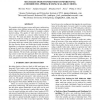Free Online Productivity Tools
i2Speak
i2Symbol
i2OCR
iTex2Img
iWeb2Print
iWeb2Shot
i2Type
iPdf2Split
iPdf2Merge
i2Bopomofo
i2Arabic
i2Style
i2Image
i2PDF
iLatex2Rtf
Sci2ools
ICMCS
2009
IEEE
2009
IEEE
Multi-rate peer-to-peer video conferencing: A distributed approach using scalable coding
We consider multi-rate peer-to-peer multi-party conferencing applications, where different receivers in the same group can receive videos at different rates using, for example, scalable layered coding. The quality of video received by each receiver can be modeled as a concave utility function of the video rate. We study and address the unique challenges introduced by multi-rate setting as compared to the single-rate case. We first determine an optimal set of tree structures for routing multi-rate content using scalable layered coding. We then develop Primal and Primal-dual based distributed algorithms to maximize aggregate utility of all receivers in all groups by multi-tree routing and show their convergence. These algorithms can be easily implemented and deployed on today's Internet. We have built a prototype video conferencing system to show that this approach offers low end-to-end delay, low complexity and high throughput, along with automatic adaptation to network conditions...
Concave Utility Function | ICMCS 2009 | Multi-party Conferencing Applications | Multimedia | Video |
| Added | 19 Feb 2011 |
| Updated | 19 Feb 2011 |
| Type | Journal |
| Year | 2009 |
| Where | ICMCS |
| Authors | Miroslav Ponec, Sudipta Sengupta, Minghua Chen, Jin Li, Philip A. Chou |
Comments (0)

